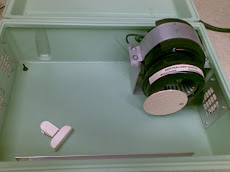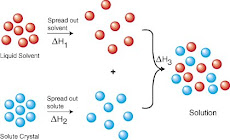 |
martes, 19 de agosto de 2014
viernes, 1 de agosto de 2014
SALMONELLA and DISINFECTANTS
Study: Salmonella Biofilms Resistant To Powerful Disinfectants
A National University of Ireland - Galway researcher has discovered the difficulties of removing salmonella after it was adhered to a surface for about a week, the university reports. The study was published in the Journal of Applied and Environmental Microbiology.
Microbiologist, Mary Corcoran, attempted to kill salmonella biofilms on various hard surfaces with three different types of disinfectants — even soaking the bacteria in disinfectant for 1.5 hours — but found the germs' viability unaffected by the chemical. Corocoran looked at the habits of salmonella biofilm on glass, stainless steel, glazed tile, concrete and plastic. It showed the biofilm of salmonella grows over time, and more firmly attaches to surfaces.
The study is considered a warning to food processing plants and other food services, who can not detect the bacteria before it has an opportunity to form biofilm on a surface.
"Food processing facilities must take strict care to keep salmonella out fo the clean areas where cooked foods get further processing and packaged, and ask whether disinfectants that are promoted as killing various types of bacteria are really as effective as claimed," Corcoran said. She added that good cleaning and appropriate food handling practices (such as regular hand washing) remained the best preventative measure to salmonella-induced illnesses.
The three disinfectants used against salmonella included sodium hypochorite (household bleach), sodium hydroxide, and benzalkonium chloride.
- See more at: http://www.cleanlink.com/news/article.asp?id=16742&email=emalaguti@chemtron.com#sthash.6sJl2wJR.dpuf
The three disinfectants used against salmonella included sodium hypochorite (household bleach), sodium hydroxide, and benzalkonium chloride.
NEW BACTERICIDAL SURFACE
Next Generation: Bactericidal Surface
A synthetic material covered in nano-spikes resembling those found on insect wings is an effective killer of diverse microbes.
By Jef Akst | November 26, 2013
“If it’s manufacturable, if it’s transferable to other surfaces and fabrics, it could be a major breakthrough,” said Stephen Kelly, a nanoparticle researcher at the U.K.’s University of Hull who was not involved in the research. “It’s interesting in itself in that it clarifies that you can have mechanical effects to kill bacteria, but more importantly, it offers the potential for antibacterial surfaces which will kill a whole range of different kinds of bugs.”
What’s new: Nanoparticles with antimicrobial effects have long been used to coat materials in clinical settings. “Bedding in hospitals, nurses uniforms, or bandages, you can make them antibacterial, soaking them in silver nitrate,” Kelly explained. But it was unclear whether the nanoparticles worked by some sort of chemical effect, with ions diffusing from the nanoparticles to the bacteria, or by physically distorting the cell wall and breaking open the cell. “The actual mode of antibacterial action of nanoparticles has been disputed for a long time,” Kelly said.
Now, microbiologist Elena Ivanova of Swinburne University of Technology in Australia and her colleagues have shown that certain nanostructures can indeed kill based on texture alone. The group had previously demonstrated that cicada wings (Psaltoda claripennis), which are covered in dense nanopillar structures, were highly lethal to the opportunistic human pathogen Pseudomonas aeruginosa, and provided evidence to suggest that the wings’ biochemical properties were not responsible. “We showed that bactericidal nature of the wing is due to the mechanical rapture of bacterial cells,” Ivanova told The Scientist in an e-mail.
“This [study] seems to state clearly that this is a mechanical effect and that you can have a very efficient antibacterial effect of a surface, which is just based on deformation of the cell wall, just stressing the cell well,” Kelly said. “It’s really novel.”
Importance: In the face of ever-evolving multidrug-resistant microbes, and with an insufficient antibiotic pipeline, an antibacterial surface could be just what the doctor ordered. “This opens the avenue of developing surfaces which have very strong antibacterial effects to kill of bacteria which are becoming resistant to all the known antibacterial agents,” said Kelly, who suspects it would be difficult for bacteria to evolve structural resistance to black silicon. “They would have to develop much thicker cell walls, which are flexible and permeable. That would be a real challenge.”
Furthermore, Kelly added, a synthetic surface has the advantage over antimicrobial nanoparticles in that it will not result in the release of nanoparticles into the environment. “Because you’re changing the surface, then it’s not getting into the ecosystem in any way.”
Needs improvement: The critical limitation to black silicon’s bacteria-fighting power is cost. The ion-beam technology used to make the material is “fairly expensive,” Kelly said, “and not generally applicable to common, cheap surfaces.” In contrast, the demand for new antimicrobial products “is a fairly low-cost, high-volume market,” he noted. “So I think manufacturability and scalability [are] the key questions.”
In the meantime, Ivanova and her colleagues “plan to explore a range of other materials [whose] surfaces maybe suitable for fabrication similar structural nano-patterns to create surfaces free from bacteria,” she said.
E.P. Ivanova et al., “Bactericidal activity of black silicon,” Nature Communications, 10.1038/ncomms3838, 2013.
DRUG TEST
Portable Lab Quickly Spots Cocaine in Urine
Tue, 07/08/2014 - 7:00am
ACS
Aaron Wheeler and colleagues explain that the current two-stage system of testing urine for drugs of abuse is expensive and time-consuming. The samples also could get lost or compromised while in transport. The ideal solution, they say, is to skip the prescreening step and instead bring the lab to the site — but in an easy-to-use, portable package. Currently, when samples arrive at labs for confirmation testing, trained technicians use a “gold-standard” method, relying on sample processing, liquid chromatography and mass spectrometry to analyze them. Small versions of instruments that implement these techniques can provide results at or near lab-quality, but they haven’t been optimized and tested together as a single, portable instrument. Wheeler’s team set out to do just that.
They put together a compact system that can do all the steps — extracting drugs of abuse from urine with a microfluidic device coupled to a small mass spectrometer that can identify the substances. The backpack-sized instrument could analyze cocaine, benzoylecgonine (a metabolite of cocaine) and codeine in four samples in less than 15 minutes. The amount of cocaine they could detect was compatible with limits set by the United Nations Office on Drugs and Crime. The researchers say the device could be used for many different kinds of tests in which laboratory-quality results are needed quickly.
The authors acknowledge funding from the Natural Sciences and Engineering Council of Canada and the U.S.National Science Foundation.
Suscribirse a:
Entradas (Atom)
Vistas de página en total
GREEN CHEMICALS
The Green Seal certification is granted by the organization with that name and has a great number of members contributing with the requirements to pass a raw material or a chemical product as "green". Generally for a material to be green, has to comply with a series of characteristics like: near neutral pH, low volatility, non combustible, non toxic to aquatic life, be biodegradable as measured by oxygen demand in accordance with the OECD definition.
Also the materials have to meet with toxicity and health requirements regarding inhalation, dermal and eye contact. There is also a specific list of materials that are prohibited or restricted from formulations, like ozone-depleting compounds and alkylphenol ethoxylates amongst others. Please go to http://www.greenseal.com/ for complete information on their requirements.
For information on current issues regarding green chemicals, see the blog from the Journalist Doris De Guzman, in the ICIS at: http://www.icis.com/blogs/green-chemicals/.
Certification is an important — and confusing — aspect of green cleaning. Third-party certification is available for products that meet standards set by Green Seal, EcoLogo, Energy Star, the Carpet & Rug Institute and others.
Manufacturers can also hire independent labs to determine whether a product is environmentally preferable and then place the manufacturer’s own eco-logo on the product; this is called self-certification. Finally, some manufacturers label a product with words like “sustainable,” “green,” or “earth friendly” without any third-party verification.
“The fact that there is not a single authoritative standard to go by adds to the confusion,” says Steven L. Mack M.Ed., director of buildings and grounds service for Ohio University, Athens, Ohio.
In www.happi.com of June 2008 edition, there is a report of Natural formulating markets that also emphasises the fact that registration of "green formulas" is very confused at present, due to lack of direction and unification of criteria and that some governmental instittion (in my opinion the EPA) should take part in this very important issue.
Also the materials have to meet with toxicity and health requirements regarding inhalation, dermal and eye contact. There is also a specific list of materials that are prohibited or restricted from formulations, like ozone-depleting compounds and alkylphenol ethoxylates amongst others. Please go to http://www.greenseal.com/ for complete information on their requirements.
For information on current issues regarding green chemicals, see the blog from the Journalist Doris De Guzman, in the ICIS at: http://www.icis.com/blogs/green-chemicals/.
Certification is an important — and confusing — aspect of green cleaning. Third-party certification is available for products that meet standards set by Green Seal, EcoLogo, Energy Star, the Carpet & Rug Institute and others.
Manufacturers can also hire independent labs to determine whether a product is environmentally preferable and then place the manufacturer’s own eco-logo on the product; this is called self-certification. Finally, some manufacturers label a product with words like “sustainable,” “green,” or “earth friendly” without any third-party verification.
“The fact that there is not a single authoritative standard to go by adds to the confusion,” says Steven L. Mack M.Ed., director of buildings and grounds service for Ohio University, Athens, Ohio.
In www.happi.com of June 2008 edition, there is a report of Natural formulating markets that also emphasises the fact that registration of "green formulas" is very confused at present, due to lack of direction and unification of criteria and that some governmental instittion (in my opinion the EPA) should take part in this very important issue.










































